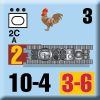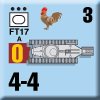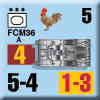| French Tanks of 1940
By Mike Bennighof, Ph.D.
February 2024
.jpg) When the Germans attacked France in the spring of 1940, the French Army fielded more and better tanks than did the panzer divisions. Putting these tanks on gamers’ tables is the major reason we published Panzer Grenadier: 1940, The Fall of France. When the Germans attacked France in the spring of 1940, the French Army fielded more and better tanks than did the panzer divisions. Putting these tanks on gamers’ tables is the major reason we published Panzer Grenadier: 1940, The Fall of France.
Poland did not field many tanks in the September Campaign of 1939; Norway and Denmark had none at all. So when the panzer divisions rolled into France in May 1940, they would encounter enemy tanks in quantity for the first time. 1940: The Fall of France has many types of scenarios, including cavalry actions and intense infantry fights, but it’s also filled with tank battles. Large-scale tank battles. So let’s have a look at some of the tanks that fought them:
Heavy Tanks
 
The Char B1bis began development in 1926, with prototypes going into testing in 1930. The tank had thick armor protection and a 75mm gun in the hull, and was intended as an infantry support vehicle. Fairly late in its lengthy development, designers added the cast APX-1 turret with a 47mm gun. That gave it formidable armament on paper, but the cast turret had no hatch, and the tank always had to be fought in “buttoned up” mode. It also could only accommodate one man, forcing the tank commander to load, aim and fire the 47mm gun as well. Unlike most other French tanks, each Char B1 had a radio — which only transmitted Morse Code, preferred by the crews since the tank’s rattling engine noise drowned out voice communications. Despite its flaws, the Char B1bis outclasses every German tank in the game with its thick armor, very high direct fire ratings and good anti-tank capability.
The much older Char 2C was unusual enough to rate its own special Daily Content piece.
Medium Tanks

Charles DeGaulle’s 507th Tank Regiment operated the Char D2 medium tank, a Renault-built vehicle mounting the same turret APX-1 cast turret as the Char B1. Intended to fight enemy tanks, the D2 was produced as Renault underwent severe financial problems, and the vehicle that emerged was poorly constructed and mechanically unreliable. One hundred were ordered in two groups of 50 each, with the second apparently intended to replace the first. Most were lost due to mechanical breakdown rather than enemy action.
Renault kept the project alive thanks to the tank’s outstanding qualities on paper: in game terms, the D2 has exactly the same abilities as the outstanding Somua S35. Polish purchasing agents were greatly impressed by the tank and asked for a license to produce it at home. Knowing the Poles’ disdain for intellectual property law, Renault balked at making the deal without substantial penalty clauses and other protections. Renault then offered the second batch of 50 tanks built for the French Army, but these were withheld from export to replace the defective vehicles of the first order.
Cavalry Tanks
 
France actually fielded two separate armored forces, each with its own procurement branch. The cavalry’s main battle tank was the Somua S35, probably the best tank fielded by any army in 1940. It was reasonably fast, with the same 47mm gun as the B1bis in a very similar turret (standardized to hold down costs). Armor protection was quite good, with the tank’s body cast rather than riveted or welded as in other nations.
The tank was not without flaws, starting with a complicated suspension system copied from the Skoda LT35. The cast body made it difficult to perform maintenance or conducted the constantly required repairs. And the tank was extremely expensive; French manufacturers did not employ the mass-production techniques common in the United States or the Soviet Union and found in some form in most industrial nations. Few plants could cast the body and turret. The APX1CE turret, though outwardly identical to that of the B1bis, had a wider base that allowed the radio operator to load the main gun (the tank commander still had to aim and fire the weapon). The tank also boasted several modern features, like self-sealing fuel tanks and an automatic fire suppression system.
Over 400 had been built by May 1940, with production scheduled to shift to the welded S40 variant that summer. Foreign armies, including Poland and Romania, sought to acquire the tank or at least a license to build it, but the French retained all of them for their own use. Close to 300 were captured by the Germans and a handful of them were still in service in 1944.
High cost and slow production frustrated plans to equip the cavalry’s armored divisions exlcusively with the S35. The infantry had rejected the Hotchkiss H35 light tank, disliking its poor steering qualities and finding it inferior to their Renault R35. But as in other democracies, there’s no such thing as failure for a defense contractor — the weapon just gets a re-imagined mission. And so the cavalry was ordered to accept the politically-connected firm’s failed infantry tank. The H35 carried the same APX turret as the R35, with a short-barreled 37mm gun. Armor was cast, often bearing manufacturing flaws. The tank had a crew of just two, a driver and a commander/gunner.
An improved version, the H39, carried a longer-barreled 37mm gun with a bigger engine and improved suspension making it faster and easier to drive. Large-scale production was ordered, with subcontractors in Britain and Portugal engaged to make cast hull sections. About 1,200 were produced, and they served in French motorized and horsed cavalry divisions as well as the cavalry’s mechanized divisions where they made up about half the division’s tank strength (with S35’s accounting for the other half). Though very much a flawed vehicle, the H35/H39 was much cheaper to produce than the S35 but French contempt for its qualities is evident — the Army did not object to licensing it to the trademark-flouting Poles.
Light Tanks
  
The Renault FT17 had been the most common French tank at the end of the Great War, and close to 2,000 remained on the inventory in 1940. Over 500 were in service and about the same number were brought forward from the material reserve during the course of the 1940 campaign. An effective weapon in 1918, by 1940 standards it was slow and lightly armored with a weak armament (all FT17 tanks in French service carried a single machine gun).
To replace the FT17, the Army issued requirements in 1933 for a new light tank than could be produced cheaply in large numbers. Fourteen companies submitted designs, but the real competition took place in the offices, restaurants and back rooms where Louis Renault and his lobbyists defeated those of rival Hotchkiss.
The tank they pushed was slow, though faster than the FT17, with reasonably good armor protection. It carried a short-barreled 37mm gun, with many of the early-production vehicles bearing weapons salvaged from condemned FT17’s. The turret was a standard APX design, also used in other light tanks. There were just two crewmen, a commander/gunner and a driver. The R35 was exported to Poland, Romania, Turkey and Yugoslavia — in all four cases, Renault used its political influence to force the tank on unwilling customers who had actually sought a different French vehicle (usually the Somua S35).
An improved version, styled the R40, had a much better suspension and the long-barreled 37mm gun but had only just entered production when France fell; the tanks equipped one French battalion and one of Polish exiles.
When it comes to arms sales in a democratic society, the result is sort of like T-ball: there are no losers. FCM’s entry in the light tank competition, the FCM36, had better protection than the other entrants thanks to its sloped armor but was considerably more expensive to produce. It rated well below the Renault and Hotchkiss entries when evaluated but nevertheless FCM received an order for 100 units — and still lost money on the deal. The FCM turret was considered superior to the APX and became the new standard for French light tanks, but it was welded rather than cast and displayed an alarming tendency to split along the welds when the long-barreled 37mm gun recoiled.
You can order 1940: The Fall of France right here.
La Campagne 1940
1940: Road to Dunkirk (boxed)
1940: The Fall of France (Playbook ed)
1940: Swallows of Death
1940: The Last Days of May
1940: Polish Exiles
Retail Price: $267.95
Package Price: $215
Gold Club Price: $172
You can order La Campagne 1940 right here.
Sign up for our newsletter right here. Your info will never be sold or transferred; we'll just use it to update you on new games and new offers.
Mike Bennighof is president of Avalanche Press and holds a doctorate in history from Emory University. A Fulbright Scholar and NASA Journalist in Space finalist, he has published a great many books, games and articles on historical subjects; people are saying that some of them are actually good.
He lives in Birmingham, Alabama with his wife and three children. He misses his Iron Dog, Leopold.
Want to keep Daily Content free of third-party ads? You can send us some love (and cash) through this link right here.
|
